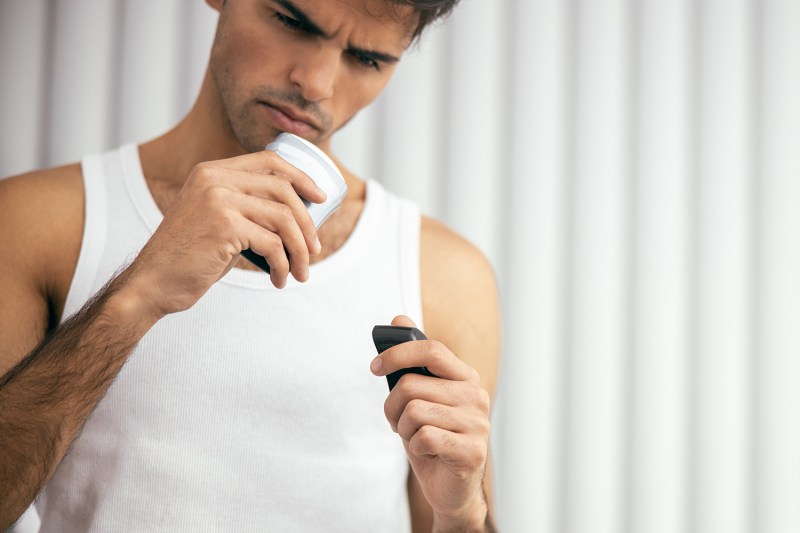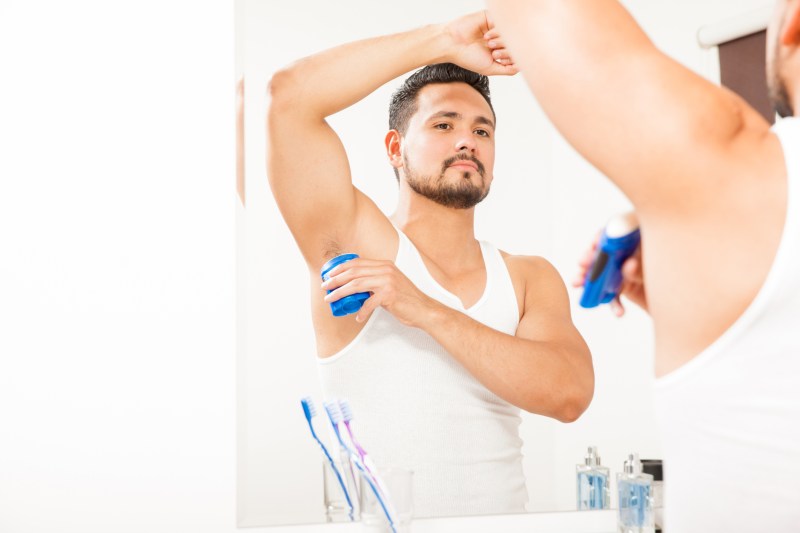
We’ll do whatever we need to do to smell good — or at least to not smell bad. But does that mean it’s better to control the odor our bodies naturally produce with deodorant or to stop the problem at its source with antiperspirant? When it concerns our grooming, it’s best to get a professional perspective on whether to use one over the other. We spoke to Mia Saini Duchnowski, co-founder and CEO of Oars+Alps, and Dr. Corey Hartman, dermatologist and spokesperson for Old Spice, to help us out.
Related Reading
What Is Antiperspirant?

An antiperspirant’s No. 1 benefit is that it eliminates wetness. Guys who are really bothered by wet underarms when the mercury starts to climb clearly fall into this camp. It may also be a concern in the workplace, where damp armpits during a big client presentation might be interpreted as nervousness. And don’t get us started on how that can complicate a first date.
“Antiperspirant contains aluminum salts, which act to plug and deactivate sweat glands, preventing perspiration and sweating,” says Hartman. “Our underarms are prone to moisture and odor. Deodorant fights the odor that comes when sweat mixes with bacteria.”
Read more: Best Antiperspirant for Men
What Is Deodorant?

“Deodorant protects against odor,” says Duchnowski, “But antiperspirant is like putting duct tape on your armpits. It blocks sweat glands from making sweat. Sure, that controls wetness, but that’s not normal (for our bodies). Deodorant includes ingredients that kill the bacteria that lead to underarm odor.”
“We use a proprietary blend that includes corn starch, which is acidic and kills the bacteria,” says Duchnowski. “When we work with guys who are switching from antiperspirant to deodorant, their biggest fear is that they are going to sweat too much. With regular use, sweat gets more normalized. It takes a little time for your body to go through a sort of ‘detox,’ and get used to what you are putting there.”
Read more: Best Deodorants for Men
Which Is Right For You?

When switching from an antiperspirant to deodorant, and vice versa — or even changing products or brands within each category — it’s not uncommon to break out initially as your body adjusts to the newcomer.
“Sometimes people get a rash and will toss their new deodorant. Again, anytime you switch products that could happen,” says Duchnowski. “Your sweat is what’s causing this. It takes time to adjust — about five to six weeks. When switching from antiperspirant, particularly, your pits are in the process of purging. You’re no longer sealing up those ducts. You may sweat more initially, too. Eventually, your body will adjust, you’ll produce fewer bacteria, you’ll sweat less, and you’ll smell less.
“Some guys will switch back and forth — they have a big meeting coming up or they switch to an antiperspirant seasonally when it gets warmer. It can be a confidence booster. I compare it to yo-yo dieting. Your body is designed to sweat. Focus on controlling the odor,” explains Duchnowski.
Hartman concurs. “When we talk to patients who are experiencing irritant or allergic contact dermatitis, it’s easy to blame a new product. Some ingredients, like fragrances and dyes, can be particularly bothersome, especially if the person has an impaired skin barrier that is not holding hydration and moisture as it should. When introducing new things into that environment, they can disrupt and cause irritation. The active ingredient in most antiperspirants is aluminum chloride salt, which is notoriously irritating. While that ingredient is very effective, one has to be careful because some products may not have been formulated correctly, or the percentage of aluminum may be too high for the product’s moisturizer content.”
Should You Use Natural Deodorants?
Oars + Alps focuses on using natural ingredients and fragrances in its deodorants, but occasionally allergic reactions can happen. “We focus on the 26 allergen-free fragrances that have been identified by the European Union,” says Duchnowski. “Another point is that sometimes a natural deodorant may cause irritation from friction because we don’t use any synthetic ingredients to make the product go on more smoothly.”
To that point, Hartman points out that two recent Old Spice introductions were designed to have the smoothest application and lowest residue for an “elegant” product. You may have seen the latest Old Spice commercials featuring the bath-towel-wrapped actor Isaiah Mustafa from the brand’s iconic campaign of a decade ago. Now Mustafa interrupts his “son” — played by Keith Powers — on the basketball court and at the office. The spots introduce Old Spice Ultra Smooth and Old Spice GentleMan’s Blend. The Ultra Smooth line includes both an antiperspirant and a deodorant; while the whole collection focuses on more subtle scents and a focus on skin benefits. GentleMan, on the other hand, is targeted toward men with more sensitive skin and features an antiperspirant and deodorant combo.
“Our skin changes approximately every 10 years,” Hartman. says. “As we age, it produces less oil, so we are able to withstand fewer harsh chemicals and irritants. It impacts our skin barrier’s ability to keep the good stuff in, and the bad, out. Switching products can become an issue, but sticking with the same product for 40 years may not work either because your skin is not the same as it was in your twenties.” This may affect anything from your favorite pit juice to laundry detergent or shaving products.
An added benefit to using either product may be that you can skip wearing other fragrances.
“Are guys still even wearing cologne today?” asks Duchnowski. “We have six different scents, so men are switching up their deodorant from day to day, rather than wearing cologne.” Oars + Alps recently launched its Buy at Oars and Alps deodorant, featuring coconut water, Sicilian sea salt, crushed almond, cedar, and sugar cane. Two of its fragrances are available in deodorants made specifically for sensitive skin, too.
One final point: This writer studiously avoided using antiperspirants for most of my adult life because I’d heard about studies touting a potential correlation between Alzheimer’s disease and the aluminum in the product. (Yet another drew a relationship between antiperspirant and breast cancer.) That was a long time ago and, at this point, there is no reason to believe there is a direct causal relationship.
Whew. Great to know I don’t have to sweat about that anymore.



